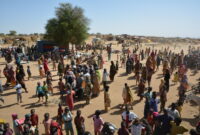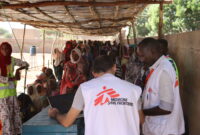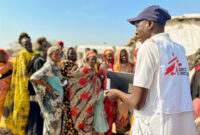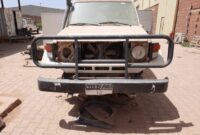Chad: Almost one year on, people fleeing Sudan’s violence continue to face an insufficient humanitarian response
Since the start of the war in Sudan 1.6 million people have fled the country seeking safety, including an estimated 610,000 [1] who have crossed into Chad. Almost a year on in the Sila region, eastern Chad, almost 92,000[2] people, most of them Chadian returnees,[3] continue to survive in very precarious conditions, putting a strain on overstretched resources that were already barely meeting the needs of the host community. In Daguessa and Goz-Aschiye alone approximately 50,000 people have settled spontaneously, their unmet needs continuing to grow due to the overall limited humanitarian response and lack of funding, despite the efforts of Médecins Sans Frontières (MSF) and other organisations.
Alimè is a Sudanese refugee who fled overnight with her daughter and found refuge in Daguessa. “I’ve seen a lot of things happening there in Sudan, such as looting. Some houses were even burned by fire. I saw people killed and wounded in front of my eyes. Even along the way, I saw people being robbed of everything they had,” she says. Like most people in Daguessa, the little help she receives to live is far from enough. Even if they have an ancestral connection with the country, many Chadians who escaped Sudan no longer have any tangible ties to it. They have arrived in Chad in search of protection and assistance like other refugees.
“I’m alone here. My husband stayed in Sudan. I came to the MSF clinic because my son is sick,” says Awa, having also sought safety in Chad. Diagnosed with severe malaria and diarrhoea, her baby has been referred and admitted to the Daguessa health centre, where another MSF team stabilises patients in critical condition. “In the camp, we all come from different places, there is no relationship between us that would allow me to get help from anyone. I don’t have a card to receive food rations. We collect straw in the bush, and we sell it to the community to have something to eat,” Awa says.
In the village of Goz-Aschiye, residents share their thin resources with the new arrivals, but food remains scarce. Distributions in this area are not enough to cover the needs of all the inhabitants, the majority Chadians who have returned to the country since the beginning of the conflict in Sudan. “One woman told me that her children hadn’t eaten anything for four days. How do you talk to someone who is dying of hunger about health and prevention?” says Goumsou Mahamat Abadida, MSF health promoter in MSF’s emergency project in the Sila region. In 2023, 1,563 patients, all under 5-year-old, were admitted to MSF nutrition programme in Sila due to acute malnutrition (500 children for severe acute malnutrition and 1,063 for moderate acute malnutrition). Acute malnutrition weakens the immune system and increases people’s vulnerability to infectious diseases, highlighting the importance of healthcare to prevent severe illness as a result.”[MSF] is trying to ensure a minimum of health services in the Goz-Aschiye camp, but it’s not enough to alleviate the huge humanitarian needs that we see in the camp,” says Goumsou.
Since May 2023, MSF team have been running a mobile clinic three days a week and two stabilisation tents with a capacity of 10 beds in Daguessa health centre. Patients with medical conditions requiring secondary care are then referred to more specialised medical centres. MSF also runs mobile clinics in Andressa and Goz-Aschiye, where the teams conduct an average of 200 and 300 consultations per week, diagnosing respiratory infections, diarrhoea and malaria, as well as many cases of severe acute malnutrition in children under five years of age.
In order to improve hygiene conditions and access to drinking water, the teams have also built several boreholes and started truck in water. However, access to drinking water still does not reach the minimum standard of 15 to 20 litres per day; most people in Daguessa have access to only 6 litres. Combined with the precarious living conditions, this only increases the risk of infectious disease.
“The humanitarian response in this remote area is still inadequate due to a lack of funds and of enough organisations on the ground, which is slowing down the delivery of aid needed to displaced people,” explains Khatab Muhy, MSF country director in Chad. “Even before the Sudanese crisis, eastern Chad was already facing chronic food insecurity. The influx of Sudanese refugees and Chadians who have returned over the past year, as well as the resulting growing needs, are putting a strain on the country’s very limited resources and fragile health infrastructure. “
[1] Source : Chad — Sudan crisis response: Flash update 28 (29 January 2024) | Displacement Tracking Matrix (iom.int) (29/01/2024) – data includes n. of refugees and returnees who have crossed into Chad from Sudan.
[2] Source : https://reliefweb.int/report/chad/iom-chad-sudan-crisis-response-situation-update-no-28-29-january-2024 29/01/2024
[3] Source : OIM https://reliefweb.int/report/chad/iom-chad-sudan-crisis-response-situation-update-no-28-29-january-2024 (29/01/2024) – IOM Definition of Returnees: advocacy-note-east-for-2024-fr.pdf (iom.int) “Chadian returnees are Chadian nationals who lived in the western regions of Sudan prior to the outbreak of violence in April 2023. Many of them had well-established lives and livelihoods in Sudan, with some running small businesses or farming on subsistence farming. The outbreak of violence in Darfur has left households with no choice but to take what they can and flee across the border into Chad.”
























































